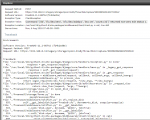klennan
Cadet
- Joined
- Aug 2, 2018
- Messages
- 8
I've managed to develop several problems all at once.
1 of 6 3TB disks failed out of a RAIDz1. I ordered a new disk.
In the meantime I thought I'd replace the OS thumb drives with faster Patriot 32GB ones. I had it mirrored, so I replaced one -no issues- then replaced the other a few days later, but FreeNAS (11 u4) wasn't happy. It also rejected the other original drive. So I was left with only the new single Patriot.
New 3TB disk arrived, so I power down, swap disks, power on - no bootable drive found. No matter what, I can't convince the machine to boot that new Patriot drive. I try the previous thumb drives with no luck either. I don't know - does FreeNAS wipe them when it replaces them?
FINALLY last night, I get the PC to boot a newly imaged Patriot, the 2nd one, I've left the first one unmodified. "newest" backup I had was from March. So I load that, but that was before I had iSCSI extents configured. It was 11 u1, I then had it upgrade to 11 u5, but instead it sucked down 11.2 BETA (or STABLE depending on which output I believe). Whatever, it boots.
That new 3TB disk fails to gpart -s gpt - "gpart: geom 'ada0': File exists" when I've written nothing to it, and "gpart: Input/output error" when using gpart destroy -F /dev/ada0
Running the destroy command a 2nd time produces "gpart: Device not configured" So that's left me with no redundancy.
-- SOLVED!
These three extents had been created as 4k blocks and presented that way. I went through various options until I deleted the extent (not underlying file) and recreated while selecting 4096 for the block size. Presented & attached them, and it's all good there!
So I've got ONE issue remaining - the 3TB hard disk that wont partition for FreeNAS.
please help :(
1 of 6 3TB disks failed out of a RAIDz1. I ordered a new disk.
In the meantime I thought I'd replace the OS thumb drives with faster Patriot 32GB ones. I had it mirrored, so I replaced one -no issues- then replaced the other a few days later, but FreeNAS (11 u4) wasn't happy. It also rejected the other original drive. So I was left with only the new single Patriot.
New 3TB disk arrived, so I power down, swap disks, power on - no bootable drive found. No matter what, I can't convince the machine to boot that new Patriot drive. I try the previous thumb drives with no luck either. I don't know - does FreeNAS wipe them when it replaces them?
FINALLY last night, I get the PC to boot a newly imaged Patriot, the 2nd one, I've left the first one unmodified. "newest" backup I had was from March. So I load that, but that was before I had iSCSI extents configured. It was 11 u1, I then had it upgrade to 11 u5, but instead it sucked down 11.2 BETA (or STABLE depending on which output I believe). Whatever, it boots.
That new 3TB disk fails to gpart -s gpt - "gpart: geom 'ada0': File exists" when I've written nothing to it, and "gpart: Input/output error" when using gpart destroy -F /dev/ada0
Running the destroy command a 2nd time produces "gpart: Device not configured" So that's left me with no redundancy.
Code:
I have a SSD in it which was home to a iSCSI extent, presented to a Windows server, and contains (hopefully) a few virtual machines. However, it shows a 25GB partition when it should be 250GB. Windows is confused. I might have now lost those VMs. On the RAIDz, I have 3 other iSCSI extents - WSUS, Veeam Server, and Veeam Client. The WSUS disk recreated just fine, presented, recognized, it's happy. It was the one I cared least about. Veeam Client - backups of my main desktop, no biggie if I lost it. But it presents and shows no partitions. Veeam Server - backups of those VMs on the ssd, plus lots of others (homelab). It presents with a 25GB partition (RAW if I online it), when it should be 3TB.
-- SOLVED!
These three extents had been created as 4k blocks and presented that way. I went through various options until I deleted the extent (not underlying file) and recreated while selecting 4096 for the block size. Presented & attached them, and it's all good there!
So I've got ONE issue remaining - the 3TB hard disk that wont partition for FreeNAS.
please help :(
Last edited:

